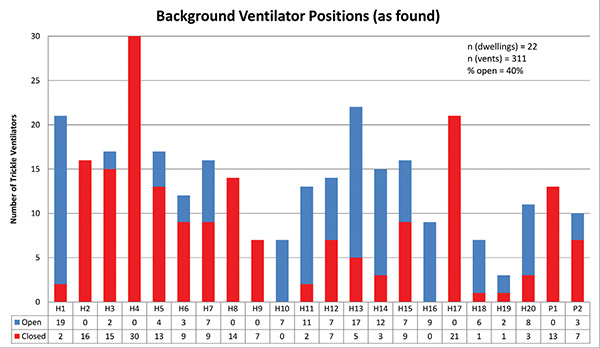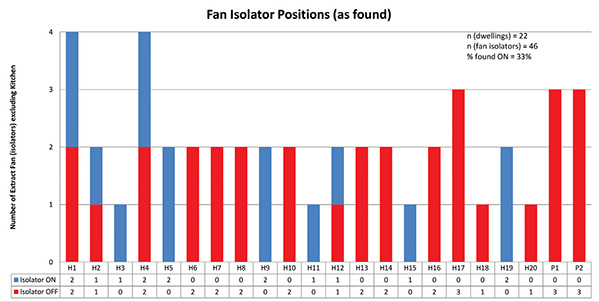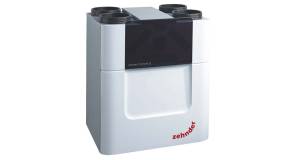
- Insight
- Posted
Natural ventilation - does it work?
Such is the importance of ventilation, it’s only right and proper that the efficacy of innovative mechanical solutions such as heat recovery ventilation and demand controlled mechanical extract ventilation is established
based on robust, comprehensive evidence. But how does natural ventilation fare when subjected to the same degree of scrutiny, and can it work in low energy buildings?
At the Alliance for Sustainable Building Products’ recent London event “Healthy Buildings, Healthy People”1 the speakers all addressed the concern that “low carbon” – for which read, airtight – homes may be endangering the health of their occupants, via reductions in air exchange and indoor air quality. This perception is widespread, despite the fact that in theory, the building regulations are supposedly ‘keeping up’ with increases in airtightness, and adapting ventilation requirements accordingly.
At the same time, there’s a lot of concern about the use of mechanical alternatives to traditional “natural” ventilation, particularly in dwellings, with mechanical ventilation perceived as complicated and potentially dangerous to health. By contrast, natural ventilation often seems to be seen as – well – “natural”, and relatively unproblematic.
Among the benefits commonly ascribed to natural ventilation are that it puts the occupant in control, it’s silent and energy efficient. People also suggest that it allows the occupants to be in contact with the outdoor environment, it’s “self regulating”, and it allows the building to “breathe”.
But does natural ventilation actually do that basic thing, give occupants enough fresh air, and remove indoor air pollution, effectively?
One person worried about this is Neil Jefferson, director of the NHBC and chief executive of the Zero Carbon Hub.
Writing in Building Magazine2 Jefferson welcomed the recent publication by the NHBC Foundation of a commendably honest account highlighting a string of concerns in the design, specification, installation, commissioning and operation of MVHR systems in 10 ‘zero carbon’ homes.3 But he went on: “There is no reason to assume that other modes of ventilation are really performing any better. MEV and PSV might well share some of the issues.”
He went on: “What about background ventilators and intermittent extract fans (aka trickle vents and cooker hood and bathroom fan)?
“Although these systems are simple to understand and use, there is anecdotal evidence suggesting that even this most simple of systems is not used properly. The trickle vents left open or closed, dependent on the weather on moving-in day; cooker hoods not used because you can’t hear the telly; and, let’s be honest, who ever cleans the filter?”
How does natural ventilation perform in theory?
Natural ventilation works by exploiting pressure differences driven by wind, or by temperature differences (the buoyancy effect), to move air in and out of different parts of a building. You can’t get away from the fact that if you’re relying on the natural forces of wind and weather to get fresh air into your building, you are at the mercy of the wind and weather. On windier days and/or days where there is a greater temperature differential between indoors and out, air will move readily and ventilation rates will tend to rise; in stiller or milder weather, ventilation rates will drop.
Bob Lowe (when he was at Leeds Metropolitan University) did some theoretical calculations based on realistic weather conditions, which he says illustrate “some of the fundamental problems” associated with natural ventilation. He carried out careful modelling taking into account both wind speed and direction, and buoyancy effect.4
He then calculated the “under-ventilation index”, meaning the proportion of the heating season for which a naturally ventilated dwelling will be underventilated without additional window opening. “At leakage rates below about 8 ACH-1 at 50 Pa, under-ventilation [for a proportion of the time] is almost assured,” he concluded.
Despite not enjoying consistently good ventilation, Dr Lowe’s calculations showed that such dwellings would lose heat unnecessarily in very cold or windy weather, and be overventilated overall: “Even at this level of leakage, the ventilation rate averaged over the heating season is significantly greater than the design ventilation rate.”
What happens in practice?
There’s very little field evidence reporting the performance of natural ventilation. A small study of 22 homes of different types was carried out in 2009 for the UK government to investigate whether Part F 2006 was providing adequate ventilation and IAQ in homes, and whether it should be updated at the next review in 2010.
The researchers were particularly keen to find relatively airtight homes, as these were the focus of concern about IAQ, and this batch ranged in permeability (measured with vents closed) from well below four (these were generally flats) to over ten (ie leakier than the supposed maximum of the day), averaging at around six air changes per hour at 50 pascals.5
The pollutants measured were moisture, TVOCs, formaldehyde and nitrogen dioxide. As the authors put it, “to assess whether ADF 2006 recommendations were adequate, it was necessary for the ventilation system to be used to its full capacity”, so occupants were asked to keep trickle vents fully open and use extract fans at their highest setting during cooking and bathing; they were asked to keep windows shut.
Air change was estimated using a gas diffusion technique, and this showed that all five flats, and 40% of the houses, failed to achieve their recommended background ventilation rate (as calculated on the basis of dwelling size and occupancy, as set out in the then Part F England & Wales).
Nitrogen dioxide levels in the kitchen exceeded performance guidelines in four homes, and over half of the homes where measurements could be taken had total volatile organic compound (TVOC) levels exceeding the guideline.
The underventilation could not however be laid directly at the door of the regulations of the time, as few if any of the dwellings had the recommended ventilation installed. The area of trickle ventilators was less than that recommended in three quarters of the homes; half did not have the required gap under doors, and less than half of the extract fans achieved recommended air flows. Flats had a particular issue in that they did not meet the Part F additional guidance for dwellings where most ventilation is on a single aspect.
There’s certainly a more widespread problem with installation and enforcement than in just this one study. The University of Strathclyde’s Stirling Howieson has reported on the basis of his recent research that “technical standards prescribed by the Building Regulations are not being enforced”6; this observation was also confirmed by delegates at a 2013 Good Homes Alliance seminar on ventilation, in which representatives from industry reported seeing many installations which in “no way had the �vent areas to meet Part F, but they were being signed off by building control”.
The undersized installations in the 2009 DCLG study gave natural ventilation an uphill struggle: in the most airtight dwellings, even with all vents open, permeability was 6 ACH @50pa or below. According to Lowe’s calculations this would leave them underventilated at least half the time across a heating season. Although it was therefore hard to appraise Part F directly, the authors of the study carried out some calculations to project likely air change rates and IAQ had the correct vents been fitted – this did suggest a number of homes would still have had problems with IAQ, in particular, TVOC levels.
The team also modelled the likely impact had all the homes been built to the levels of the most airtight: unsurprisingly, IAQ problems would have been much more frequent, with 3/4 of the dwellings likely to exceed TVOC guidelines.
However if this is a problem in airtight dwellings, perhaps people enjoy better IAQ in leaky homes? Well, no, not necessarily.
In 2002, a study of ventilation and IAQ in 37 homes was published. Although they’d all been built since 1995, after Part L began to require buildings to attempt to keep out cold draughts, the homes were actually pretty much as leaky as the general UK stock – with ACH @50Pa ranging from 5 to 20, averaging around 12. Air change rates were estimated, and the indoor air pollutants carbon monoxide and nitrogen dioxide were recorded.7
Despite the leakiness of the sample, once again, the majority (68%) of the sample had below the recommended design air change rate of 0.5 ACH. Air change rates averaged around 0.4 ACH but over a wide range, with the poorest example only showing 0.19 ACH.
This study was different from the later one, though, in that occupants were free to use vents and windows as normal. However: “most occupants were unaware of trickle vent usage and they were fully open in only four homes and were fully closed in 13 of the homes. Those homes with trickle vents fully closed had the lowest ventilation rates in winter.” In summer, things were better but nonetheless 30% of homes still had a whole house ventilation rate below 0.5 ACH.
Some homes also suffered indoor air pollution issues: in winter 18% of the homes had kitchen CO levels above WHO guidelines, and even in summer, 13% did. In winter the kitchens of six homes also exceeded NO2 guideline values – pollution was worse in homes with gas cooking, smoking, or high occupancy.
Occupant use of ventilation systems
It isn’t known what the air change rates would have been with all vents open in this sample, but it’s clear from differences in the results that occupant behaviour was a determining factor in ventilation rates even in these “leaky” homes: “Air change rates did not correlate especially closely with airtightness of the fabric, but there were clear trends for homes who reported vents and windows open most of the time to have the higher rates.”8
Thus even in the days before airtightness standards had begun to bite, occupant behaviour was key to air quality. As fabric has become more airtight, the regulatory requirements for background ventilation supplied via extract fans, trickle vents and window opening have been increased. While this has clearly been necessary, it does also mean that the relative importance of occupant behaviour has also steadily increased.
So are occupants keeping up, and modifying their behaviour to at least maintain the patchy air quality of yesteryear? Well, perhaps the most alarming finding of the 2009 DCLG study was one of the very first observations the researchers made.

When they first arrived, researchers examined the way ventilation was normally being used by the occupants day-to-day. The findings are well illustrated in the graphics above and below. In the first chart, the red portions of the bars represent closed vents, the blue, open; in the second, the blue bars represent extract fans with power supply connected, the red, those which had been turned off via the isolators.9

Thus overall, 60% of ventilators were found in the closed position, though 73% of occupants stated these were “usually open”. Many occupants said they thought the vents caused draughts. With kitchen and bathroom extracts, six of the 22 households didn’t use extract fans at all, five said they used the isolator to control some of their fans (though in fact many more did this); the reasons given were that the noise, and run-on timer, were a “nuisance”. Only three of those households that did use kitchen extracts used them correctly – ie on boost while cooking; one household had requested and received a lower-power fan because the original was too noisy for them.
Bearing in mind that the patchy IAQ results reported in this study were with all vents open, the fact that there was usually a lot less ventilation in these homes has worrying implications for IAQ in the normal course of events.
Occupant impact was also highlighted in a Good Homes Alliance report10 presenting examples of good ventilation practice in low energy homes. In the few projects with natural ventilation included (three with vents plus humidistat-controlled extract, two with passive heat recovery, and one with a passive stack system) two of the six dwellings had had poor IAQ, which was attributed to occupant behaviour - in both cases, occupants said they had closed vents/shut off fans because of noise or draughts. IAQ was poor in both cases.
Another, very recent study also shows that natural ventilation tends not to be used as intended and fails to give good IAQ. Stirling Howieson and colleagues in the faculty of engineering at the University of Strathclyde looked at 24 new-build homes constructed to 2010 regulations with an airtightness standard of 5m3/m2/hr@50Pa, where trickle vents in the windows provided the only source of background ventilation.11
CO2 levels measured in occupied bedrooms “were found to be at unacceptable concentrations” (occupied mean peak of 2317 ppm with a maximum of 4800 ppm). “Such high levels confirm that airtight dwellings with only trickle ventilators as the ‘planned’ ventilation strategy do not meet the standards demanded by the Building Regulations,” the authors write, adding: “Such high concentrations of carbon dioxide are invariably found in bad company;” – with pollution from VOCs off-gassing from furniture and fittings liable to be leading to indoor air pollution, they suggest.
Some data is now also becoming available from the low-energy retrofits carried out under ‘Retrofit for the Future’. A small case study of nine participating homes in Yorkshire, by URBED architect Marianne Heaslip, showed that over a cold but wet week of monitoring (in November 2011) relative humidity in the two homes with passive stack ventilation (with trickle vent inlets) was “at the higher end” of all the results, with RH ranging between 50% and 70%, except for one bedroom in one of the houses, where levels were between the high 70s and 90%. The one home with passive vents plus mechanical extract had high RH, ranging between 60 and 80%, and consistently above 70% in two of the three rooms monitored.
The researcher went on to observe, though, that “the residents of [the homes with the natural vents and PSV systems] were ... energy conscious, and appeared to have a tendency to shut their trickle vents”.
How do we know when to open the vents?
As we saw at the start, among the benefits commonly ascribed to natural ventilation are that it’s easy to understand, culturally familiar, and it “puts the occupant in control.” The sense of being able to control indoor conditions is a real component of comfort – knowing they can alter them actually increases people’s tolerance of less-than-perfect conditions.
So, while we are told that a “rapid, detectable response in IAQ correlates with satisfaction”12 – what changes in IAQ can people actually detect?
The findings of the case studies reported by the Good Homes Alliance suggest we are not at all sensitive to high levels of CO2 or relative humidity.
In one house, where there was a mean CO2 of 1160ppm, and RH averaging near 70% and peaking at 90%, the occupant described the indoor air quality as ‘good’, but the GHA points out that “The IAQ in this dwelling is not ‘good’ and is presented for information only”. In the other house with poor IAQ (as residents had closed most trickle vents and turned off fans in bathrooms and toilet, due to noise), the occupants did not complain of feeling stuffy “therefore this problem may not have been picked up without the monitoring”.
Aside from steamy bathrooms and burnt toast, probably the most usual driver for increasing ventilation is not strictly IAQ, but occupants feeling too warm. People understand that it’s usually cooler outside than in – and open the windows to make themselves more comfortable. For this reason, they will often understand a warm room to be “badly ventilated” even if ACH and RH happen to be good, and CO2 and toxins are all acceptably low.
But of course what people are after here is not ventilation per se – it’s cooling. And it seems that it is not just the unschooled ordinary user who makes this conflation, as we’ll see below. But the fact that occupants can’t automatically detect poor IAQ makes it inevitable that occupant controlled ventilation will be a hit-and-miss affair. In the studies above, many occupants in real life were indeed, missing not hitting, and living in conditions of underventilation, and unsatisfactory IAQ.
Energy efficient ventilation – or energy efficient cooling?
As well as being easy to understand and under occupant control, natural ventilation is often described as being energy efficient. For example, on the CIBSE website you can read: “Ventilation can be provided through a number of methods, the most energy efficient being a natural ventilation strategy.”13
When you look more closely at commentary suggesting that natural ventilation is “energy efficient”, you often find that the authors, like ordinary building users when asked about ventilation, tend to be thinking mainly about natural ventilation as cooling. (This is particularly common when the commentator deals with a lot of non-domestic building).
Of course, natural ventilation, or “opening a window” is indeed a very energy efficient means of cooling, and gives excellent occupant control, which is why so many mechanically ventilated buildings (including all such homes) also offer natural cooling via opening windows. For this reason the energy savings from natural cooling have to be considered separately from the energy savings/costs entailed by the background ventilation system of choice – they are separate services.
The other potential pitfall when comparing the energy use of two different (background) ventilation strategies is that one should endeavour to compare like with like. As Bob Lowe put it: “In households that place greater value on energy conservation than on air quality, it is possible for natural ventilation in an airtight house to outperform mechanical ventilation in terms of energy and carbon emissions, by the simple expedient of not opening the windows.”
Thus, when comparing the energy used by different ventilation systems, it should be the energy used when delivering similar comfort conditions and IAQ in each case. But it’s not always clear that this is allowed for.
Passive stack ventilation
Most of the discussion here has related to conventional “natural ventilation” ie with background ventilators, usually window trickle vents but also sometimes air bricks, plus mechanical extract in kitchens and bathrooms. There are even fewer studies on passive stack ventilation than there are on this more conventional system. Cranfield University’s Derrick Crump who has reviewed most of the data that is available, has the impression that PSV performs similarly to the trickle vent/extract system in practice – “It’s no better, but no worse,” he told Passive House Plus.
More recent passive stack installations have tended to include “demand control” – humidity sensors to increase or decrease vent openings. However performance data is thin on the ground, and the most recent studies in dwellings have tended to be of fan-assisted passive stack ventilation.
Can natural ventilation be made to work reliably?
Certainly there are commentators who feel very strongly that the regulations, at least in the UK, are not fit for purpose when it comes to natural ventilation. Stirling Howieson is particularly critical of the gap between the “simplistic and unrealistic assumptions” used in mathematical modelling of ventilation – such as, that all doors would be open and all trickle ventilators unobstructed; his research has demonstrated that “in ‘real life’ situations, this is not the case and could lead to significant risks of underventilation.” The regular occurrence of underventilation is confirmed by much of the research cited above: instances of one or other – or several – air quality problems were found in a significant proportion of all the homes studied.
It’s been pretty much impossible to find whether the recommendations for natural ventilation in the building regulations for England and Wales, if installed and operated as the authors of Part F intend, deliver consistently good IAQ – there are just too few examples.
There’s also a possibility that the regulatory targets for RH in particular are not ambitious enough – Part F (England & Wales) considers that a “monthly average” RH of 65% is satisfactory, as is a “weekly average” of 75%.
This is “in order to lower the risk of condensation”. There is however quite a bit of research suggesting that in order to reduce the risk of house dust mite problems (mites are known to exacerbate asthma in particular) RH below 60%, or even lower, should be sought. Thus the reviews of the Retrofit for the Future projects generally refer to RH below 70% as only “acceptable”, with RH of 40%-60% described as “good”.14
There are also suggestions that contrary to general expectation, buildings may become more airtight as they age – which may also present an issue for ventilation design recommendations. 15
But the problem may be just as much cultural – or, even, philosophical, as it is technical. Who is, in the end, responsible for IAQ?
The regulations, and the designers and builders who follow them, make a tacit assumption that users will actively manage ventilation for good IAQ. And indeed, some do. But far too many don’t, meaning this laissez-faire approach is costing health, and even lives.16
One often hears concerns that mechanical ventilation systems require a “whole culture change” or impose a “new lifestyle” on occupants. Yet it appears that a significant lifestyle change is required for many occupants to adapt to living safely in naturally ventilated homes now.
Technical solutions designed to deliver more consistent IAQ in natural ventilation systems, such as the use of CO2 or moisture monitors either to control the ventilation, or to alert occupants to the need to adjust it, have been devised. But there’s almost no monitoring data to demonstrate whether they actually work – and work to maintain low levels of pollutants that the sensors don’t detect, such as VOCs, radon, or the products of combustion – without compromising energy saving or comfort. Until and unless data become available, neither designers, householders, nor the regulatory authorities can take a view on any of these new approaches. Yet again and again, as we have seen ad nauseam in the field of building energy use, we are offered calculations, but few actual facts. Performance data – and, critically, performance feedback to designers and installers, is pitifully scarce. (There is more monitoring data relating to mechanical ventilation and to hybrid systems, with and without sensor control – but still not a lot, and the issue of feedback to designers and installers is of course just as critical here.)
What we are facing could fairly be described as a “ventilation performance gap”. As Amory Lovins famously said: “Any system without feedback is stupid”. Without feedback, it’s hard to see how the ventilation design, installation and operation systems in our homes will become fit for purpose.
It’s becoming apparent that something has to change, as evidence mounts of the links between poor IAQ and a very distressing and expensive burden of ill-health. As people in fuel poverty reportedly ask for their gas to be cut off for fear of getting into debt17, and the UK’s “bedroom tax” and soaring rents force low-income households into smaller and smaller spaces, IAQ, and public health, is not going to be improving.
Let’s hope that whatever solutions are proposed, are proposed on the basis of hard evidence that they actually work, when deployed in the homes of actual people.
Additional info
What ventilation is for:
• Background ventilation: remove pollutants/replace with fresh air
• Cooling: remove unwanted heat
Pollutants include
• CO2 from occupants
• Excess moisture from occupants and their activities (and also, possibly rain or groundwater getting into the building fabric)
• Chemical and particulate toxins and irritants from, for example, products of combustion (gas cookers, smoking, candles) cleaning products toiletries and “room fragrances”, building components and finishes, hard and soft furnishings and appliances (eg plastics and resins, foam mattresses) and in non-domestic buildings, equipment such as printers and photocopiers
• Smells
• Radon from underground.
In domestic buildings, moisture is often the most troublesome pollutant. High, variable and unpredictable amounts can be generated indoors, and when not removed it can lead to the proliferation of moulds and house dust mites, both of which cause or exacerbate serious and common health problems in many vulnerable people. As Lynn Sullivan, who chaired the 2009 Part F England & Wales working party, put it, drying a load of laundry indoors means releasing more than one and a half litres moisture into your home, “which is quite a challenge for any ventilation system”.
Combustion products may exacerbate both asthma and cardiovascular disease; Radon, VOCs and some combustion products are also implicated in cancer, in particular, lung cancer.
In non-domestic buildings, CO2 may be the pollutant which is likeliest to build to unwanted levels, and high occupancy means that if ventilation is inadequate levels may be high enough to affect alertness. This has been borne out by monitoring studies in schools.
1 Alliance for Sustainable Building Products http://www.asbp.org.uk/
2 http://www.building.co.uk/we-need-to-know-all-ventilationsystems-are-safe/5062555.article
3 Assessment of MVHR systems and air quality in zero carbon homes NHBC Foundation August 2013
4 Building Services, Engineering, Research & Technology 21(3) 179-186 R. J. Lowe - Ventilation Strategy, Energy Use and CO2 Emissions in Dwellings - a Theoretical Approach
5 Ventilation and Indoor Air Quality in Part F 2006 Homes BD 2702 DCLG 2010
6 “Are our homes making us ill?”, Stirling Howieson, University of Strathclyde. Perspectives in Public Health 2014 in press https://pure.strath.ac.uk/portal/en/publications/are-ourhomes-making-us-ill%280b8ce07f-b36d-499f-8caa-08c249f241ac%29.html
7 VENTILATION AND INDOOR AIR QUALITY IN NEW HOMES Crump, Dimitroulopoulou et al BRE, Watford, http://www.umad.de/infos/cleanair13/pdf/full_104.pdf
8 The preceding two studies also summarised in https://www.cranfield.ac.uk/about/people-and-resources/schoolsand-departments/school-of-applied-sciences/groups-institutesand-centres/ieh-reports-/air-pollution/w28.pdf
9 http://manchesterismyplanet.com/energyandbuildings/gmlow-carbon-housing-retrofit, talk by Ian Mawditt.
10 http://www.goodhomes.org.uk/downloads/news/VIAQ%20final%20120220%20-%20PUBLICATION.pdf
11 https://pure.strath.ac.uk/portal/en/publications/are-our-homesmaking-us-ill%280b8ce07f-b36d-499f-8caa-08c249f241ac%29.html http://bse.sagepub.com/content/early/2013/11/27/0143624413510307.abstract ($36)
12 Fionn Stevenson, talk to Good Homes Alliance, 10 Nov 2010
13 http://www.cibseenergycentre.co.uk/ventilation.html
14 Residential Retrofit, Marion Baeli, RIBA books 2013. See also Lawrence Berkeley National Laboratory, http://www.iaqscience.lbl.gov/dampness-impacts.html
15 In one NHBC study, eight of 23 homes became more airtight 1-3 years after completion. In the NHBC’s Greenwatt Way study, 9 out of 10 homes became more airtight.
16 As Stirling Howieson put it: “If policy action is not forthcoming, it is highly likely that the morbidity and mortality caused by the failure to take expedient action over asbestos in buildings, will be surpassed.”
17 http://www.theguardian.com/society/2013/dec/27/damp-socialhousing-residents-heating-energy-bills
- Issue 6
- Ventilation
- natural ventilation
- low energy design
- heat recovery ventilation
- mechanical ventilation heat recovery
- MVHR




